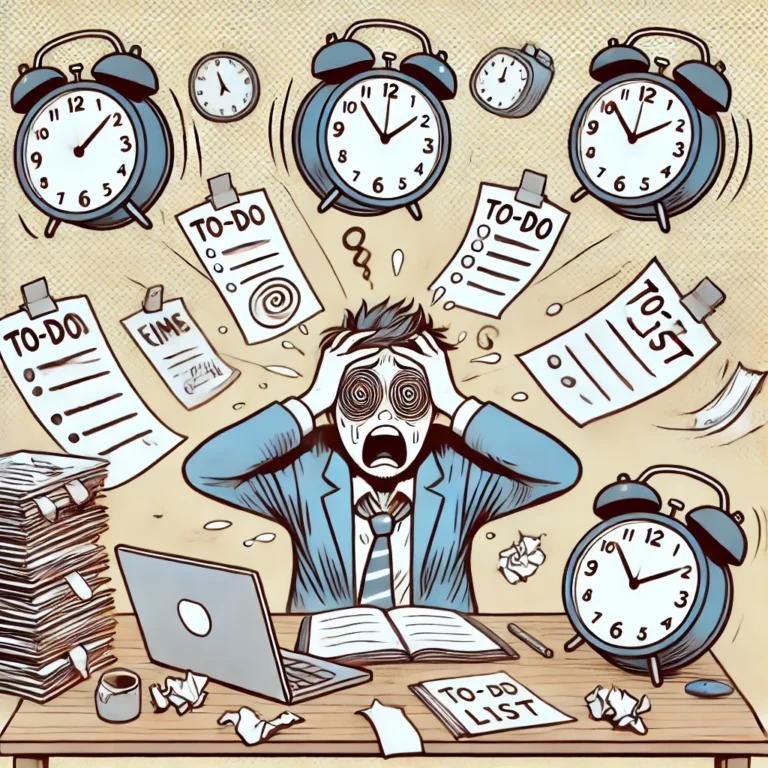The Science Behind Productivity & How to Work Smarter

Introduction
Productivity isn’t simply about clocking in extra hours or checking items off your to-do list. It’s a science—an interplay between neuroscience, psychology, and proven time management techniques. In this comprehensive guide, we’ll dive deep into the latest research on productivity hacks, exploring methods that help you work smarter, not harder. Whether you’re striving for a better work-life balance, looking to optimize your workflow, or simply searching for ways to boost your motivation, this article is packed with actionable strategies and engaging insights.
1. The Brain’s Focus Mode vs. Diffuse Mode
Your brain operates in two distinct modes:
- Focus Mode: The state of deep, concentrated work that enables you to solve complex problems and complete demanding tasks.
- Diffuse Mode: A relaxed state that allows your mind to wander, make connections, and process information subconsciously.
How It Works:
When you engage in focus mode, you’re leveraging your brain’s ability to concentrate intensely on a specific problem. However, prolonged focus can lead to mental fatigue. That’s where diffuse mode comes into play—taking short breaks or engaging in light activities enables your brain to rest and reboot, ultimately increasing overall efficiency.
Practical Tip:
Implement the Pomodoro Technique: work for 25 minutes, then take a 5-minute break. This balance between intense focus and periodic relaxation maximizes productivity and prevents burnout.
🖼️ Cartoon Illustration:
Imagine a cheerful brain character switching between two moods: one side is illuminated with gears and bright ideas (focus mode), and the other is lounging in a hammock with soft clouds overhead (diffuse mode). The playful depiction helps visualize the necessity of balancing concentration with relaxation.

2. The Role of Circadian Rhythms in Productivity
Our bodies are governed by circadian rhythms—the internal clocks that regulate sleep, energy, and cognitive performance throughout the day.
Key Insights:
- Morning: Generally, your brain is at its peak for analytical tasks. Use this time for deep work and problem-solving.
- Afternoon: Energy levels dip as your body digests lunch and transitions to routine tasks.
- Evening: Creativity often peaks, making it a great time for brainstorming and planning.
How to Work Smarter:
Schedule tasks according to your body’s natural energy cycles. Tackle high-priority projects when your focus is sharp and save administrative tasks for times when your energy naturally wanes.
🖼️ Cartoon Illustration:
Picture a character riding an “energy wave” throughout a day, with a clock showing different times. In the morning, the character is vibrant and focused; in the afternoon, they slow down, and in the evening, creativity sparkles around them. This visual reinforces the idea of aligning tasks with natural energy peaks.

3. The Science of Multitasking (And Why It Doesn’t Work)
Though many believe multitasking is a hallmark of efficiency, neuroscience shows that it can reduce productivity by as much as 40%. When you multitask, your brain is constantly switching focus, which leads to cognitive overload and errors.
The Problem with Multitasking:
- It forces your brain to divide attention, slowing down overall performance.
- Multitasking increases stress levels and decreases the quality of work.
Work Smarter Tip:
Embrace monotasking. Focus on one task at a time to improve accuracy and efficiency. Use productivity tools and apps that help you minimize distractions.
🖼️ Cartoon Illustration:
Visualize a character frantically juggling multiple objects (representing tasks) and dropping some, contrasted with another character calmly focusing on one task at a time with a single glowing object. This stark contrast highlights the benefits of monotasking.

4. The Power of Dopamine & Motivation
Dopamine, often dubbed the “motivation chemical,” plays a crucial role in how we approach work. Every time you complete a task, your brain releases dopamine, creating a rewarding feeling that encourages you to keep going.
Leveraging Dopamine for Productivity:
- Break Tasks Down: Divide larger projects into smaller, manageable steps to trigger dopamine releases more frequently.
- Celebrate Small Wins: Acknowledge each milestone; it reinforces positive behavior and boosts motivation.
Work Smarter Strategy:
Create a checklist of mini-goals throughout your day. This not only provides a clear structure but also ensures you experience regular bursts of motivation as you tick off completed tasks.
🖼️ Cartoon Illustration:
Imagine a cheerful character checking off a to-do list, with a progress bar that fills up with glowing, animated dopamine molecules. This visual metaphor illustrates how small achievements build up motivation.

5. The 2-Minute Rule for Beating Procrastination
Procrastination can sabotage even the best-laid plans. The 2-minute rule, introduced by productivity expert David Allen, is a simple yet effective strategy to combat procrastination.
How It Works:
- If a task takes less than 2 minutes, do it immediately.
- If it takes longer, break it down into smaller tasks until it fits within the 2-minute window.
Benefits:
This approach prevents tasks from piling up, reduces mental clutter, and helps maintain a steady flow of productivity throughout the day.
🖼️ Cartoon Illustration:
Visualize a character glancing at a stopwatch and quickly handling small tasks—like replying to a short email or tidying up a desk—while another pile of tasks is kept neatly organized. This playful scene underscores the efficiency of the 2-minute rule.

6. The Role of Sleep & Nutrition in Productivity
Your brain’s performance is intimately linked with the quality of your sleep and the nutrients you consume.
Critical Points:
- Sleep: Lack of sleep can significantly impair cognitive functions, memory, and decision-making. Aim for 7-9 hours of quality sleep per night.
- Nutrition: A balanced diet rich in omega-3 fatty acids, whole grains, and leafy greens fuels your brain and maintains high energy levels. Avoid excessive sugar and processed foods that can lead to energy crashes.
Work Smarter Tip:
Integrate short naps or power naps into your routine if possible, and plan nutritious meals and snacks that sustain your focus throughout the day.
🖼️ Cartoon Illustration:
Imagine two contrasting scenarios: one character is groggy and overwhelmed surrounded by junk food, while another is bright-eyed and alert, enjoying a healthy snack with fruits, vegetables, and a cup of herbal tea. This illustration highlights the stark difference nutrition and sleep quality can make.

7. The Eisenhower Matrix: Prioritizing What Truly Matters
The Eisenhower Matrix is a time-tested productivity tool that helps you prioritize tasks based on urgency and importance.
How It Works:
- Urgent & Important: Do these tasks immediately.
- Important but Not Urgent: Schedule these tasks.
- Urgent but Not Important: Delegate them.
- Neither Urgent nor Important: Eliminate these tasks.
Why It’s Effective:
By categorizing tasks, you ensure that your focus is directed toward high-impact activities rather than busywork. This method not only improves efficiency but also reduces stress by clarifying your priorities.
🖼️ Cartoon Illustration:
Picture a colorful matrix divided into four quadrants, with a character happily placing sticky notes into the correct boxes. Each quadrant is represented by different icons—like clocks for urgency and checkmarks for importance—making the concept visually engaging and easy to understand.

8. Advanced Time Management Techniques
Beyond the Pomodoro Technique and the 2-minute rule, there are several advanced methods to further boost productivity.
Popular Techniques Include:
- Time Blocking: Allocate specific time slots for different tasks throughout the day.
- Batch Processing: Group similar tasks together to reduce the cognitive load of switching between different types of work.
- Digital Detox: Regularly unplug from digital distractions to refresh your mind and improve focus.
Work Smarter Tip:
Experiment with various techniques to find the combination that best suits your personal work rhythm. Consistency is key—once you find what works, stick with it and tweak as necessary.
🖼️ Cartoon Illustration:
Imagine a character at a desk with a calendar and various clocks, organizing different tasks into color-coded time blocks. The scene includes visual representations of batching and a “Do Not Disturb” sign, symbolizing a digital detox. This illustration helps convey the importance of structured time management.

9. Leveraging Technology: Best Productivity Tools
In today’s digital era, countless tools are designed to help you work smarter. From project management software to focus-enhancing apps, leveraging the right technology can significantly boost productivity.
Top Recommendations:
- Task Management Apps: Tools like Todoist, Asana, or Trello help you organize tasks and deadlines.
- Focus Apps: Use apps like Forest or Focus@Will to minimize distractions and enhance concentration.
- Automation Tools: Streamline repetitive tasks with automation tools such as Zapier or IFTTT.
How It Helps:
These tools not only simplify your workflow but also ensure that you’re spending your time on tasks that truly matter, allowing you to increase efficiency and productivity.
🖼️ Cartoon Illustration:
Visualize a character happily interacting with a dashboard filled with colorful icons representing various productivity apps and tools. The character’s workspace is neat and organized, reinforcing how technology can simplify daily tasks.

10. Crafting a Personalized Productivity Blueprint
Finally, remember that productivity isn’t one-size-fits-all. Creating a personalized productivity blueprint involves assessing your unique strengths, weaknesses, and daily rhythms.
Steps to Create Your Blueprint:
- Self-Assessment: Identify when you are most productive during the day.
- Goal Setting: Define clear, measurable goals that align with your long-term vision.
- Regular Reviews: Periodically evaluate your progress and adjust your strategies as needed.
- Flexibility: Allow yourself to experiment with different techniques and modify your routine for continuous improvement.
🖼️ Cartoon Illustration:
Imagine a character holding a blueprint or roadmap, surrounded by various icons symbolizing different productivity strategies. This visual encourages personalization and constant refinement of your workflow.

Conclusion
Understanding the science behind productivity is key to working smarter and achieving more without burning out. By balancing your brain’s focus and diffuse modes, aligning tasks with your circadian rhythm, eliminating multitasking, leveraging dopamine, and using advanced time management techniques, you can transform your workday. Incorporate these productivity hacks into your routine, and you’ll not only increase efficiency but also create a healthier work-life balance.
SEO & AdSense Keywords: productivity hacks, work smarter not harder, time management techniques, how to focus better, increase efficiency, best productivity tools, boost motivation, stop procrastination, work-life balance, neuroscience productivity, optimize workflow, Pomodoro Technique, Eisenhower Matrix.
Implement these science-backed strategies and watch your productivity soar!






Good day! Do you use Twitter? I’d like to follow you if that would be okay. I’m definitely enjoying your blog and look forward to new posts.
What i don’t understood is actually how you’re not actually much more well-liked than you may be now. You are very intelligent. You realize thus significantly relating to this subject, made me personally consider it from a lot of varied angles. Its like women and men aren’t fascinated unless it is one thing to do with Lady gaga! Your own stuffs great. Always maintain it up!
I抳e been exploring for a little for any high quality articles or blog posts on this sort of area . Exploring in Yahoo I at last stumbled upon this website. Reading this information So i am happy to convey that I have a very good uncanny feeling I discovered exactly what I needed. I most certainly will make certain to don抰 forget this web site and give it a look on a constant basis.
What抯 Happening i am new to this, I stumbled upon this I have discovered It positively useful and it has helped me out loads. I hope to contribute & help different customers like its aided me. Great job.
May I request more information on the subject? http://www.ifashionstyles.com All of your articles are extremely useful to me. Thank you!
The articles you write help me a lot and I like the topic http://www.hairstylesvip.com